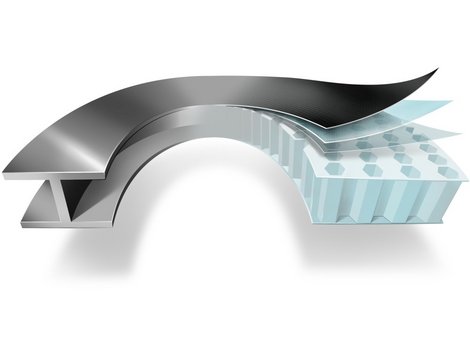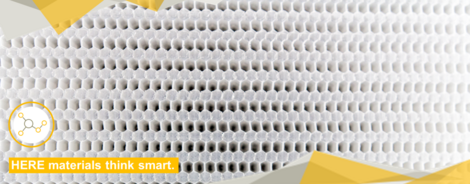Lightweight Construction Taken to a New Dimension in Halle

ThermHex Waben GmbH and the Fraunhofer IMWS in Halle (Saale) focus on new hierarchical sandwich structures
ThermHex Waben GmbH in Halle produces honeycomb cores, which are becoming ever more important around the world as a lightweight construction material. Together with the Fraunhofer IMWS, also based in Halle, the company is currently working on a new technology designed to make lightweight construction even more powerful and opening up new dimensions with its hierarchical sandwich structures.
Lightweight construction materials are now a necessity: they are used in all types of construction, from airplanes and vehicles to ships and containers. The material has to meet very stringent requirements – the quality has to be right, and there must be an optimum relationship between the material properties, weight and cost. “An increasing number of industrial sectors are faced with the need to reduce the weight and cost of their large, flat structures. We offer the just the products to make that happen and, what’s more, they are manufactured in an environmentally friendly way,” says Dr. Jochen Pflug, CEO of ThermHex Waben GmbH. Founded in 2009, the company has made a name for itself on the international stage with thermoplastic honeycomb cores made of polypropylene (PP) that it manufactures continuously in high volumes with the help of its unique production technology. Designed for premium sandwich panels and lightweight components, these honeycomb cores combine everything that European commercial vehicle manufacturers in particular really value. The ThermHex honeycomb panels are built in sandwich structures and can be found anywhere where an ideal combination of strength, weight and cost is needed – in the interior construction of ships, modern swimming pools, furniture, truck walls, luggage trunk floors, rear shelves or door panels.
“Non-stop ideas”
The Organosandwich was released in 2019 and is a PP honeycomb core with a fiberglass PP top layer. It is already seen as a bit of an insider tip in the automotive industry. For Pflug, it is the logical next step in development: “The sandwich can be functionalized easily and economically by injection molding and can be processed in series and in very short cycle times to produce a finished component.” In order to be able to offer innovative, quality products at all times, the company listens to the ideas for new projects regularly suggested by industry partners and “never stops shaping and developing these ideas.” To bring these new ideas to fruition, ThermHex has been drawing on its long-standing economic expertise and collaborating with its Halle-based neighbor the Fraunhofer Institute for Microstructure of Materials and Systems IMWS since 2015. Pflug says that the process developments for the Organosandwich material are being watched with great interest by industry.
Development of a new fundamental technology
As part of another joint project funded by the European research initiative EUREKA with the label “Hierarchical Hexagonal Sandwich Honeycomb Core, HiHex,” various companies and the Fraunhofer IMWS are working on a new fundamental technology. “We are focusing on hierarchical sandwich structures where the top layer itself is also a sandwich,” explains Dr. Ralf Schlimper, Group Leader for the Assessment of Composite Systems at the Fraunhofer IMWS. “This allows us to make lightweight construction even more powerful by making more effective use of the sandwich principle.” There are already powerful and cost-efficient core materials available in the form of the thermoplastic honeycomb cores that are currently used in lightweight construction. However, these are limited in terms of their mechanical performance, particularly in comparison with more costly honeycomb cores, says Pflug. That’s why they are often used for applications “that carry less load,” such as in cladding and interior components. This is where the project comes in. “We want to overcome the low buckling strength of thin thermoplastic honeycomb-cell walls by using a hierarchical material,” explains Schlimper. The stability of the honeycomb core can be significantly increased if each honeycomb-cell wall itself is formed of a honeycomb sandwich, while weighing the same or even becoming lighter.
Patented sandwich structure in cell walls and top layers
ThermHex and the Fraunhofer IMWS are also researching yet another area: the capacity for hierarchically structured top layers to improve load distribution and surface quality. By investigating these types of sandwich structures, the collaborative partners expect to be able to describe and assess their physical properties. Project Leader Schlimper is confident about the future of this joint research: “We can advance and coordinate the development of cost-efficient and powerful hierarchical sandwich structures for the long term.” Crucially, the new thermoplastic honeycomb structures will “ensure more automation in production and lower material costs as an alternative to structures used thus far.” Pflug is also convinced that they could start “a mini revolution.” He says: “Our hierarchical sandwich structure, which is already patented, achieves improved material properties, and optimized weight in particular.”
Initiating an international conference
The partners have caught the attention of the global composite sector by establishing an international composite sandwich conference that is due to take place every two years and will bring together experts from all over the world in Halle. The collaborative partners always have something new to report. Pflug says: “We have established an excellent footing in the sandwich structure sector because both partners bring their experiences to the table and implement innovative projects. These types of forward-looking projects, such as the hierarchical core and honeycomb cores made of high-temperature thermoplastics, demonstrate that we occupy a leading role when it comes to lightweight sandwich structures.” Schlimper adds that they benefit hugely from Halle as a well-placed location. “The fact that everything is so close by is a big bonus for the area. We can collaborate with others and promote development.”
Author: Manuela Bock/IMG Saxony-Anhalt

One can rightly claim that Saxony-Anhalt is an innovative commercial and scientific site for smart materials. Here, innovations for the global market are created with entirely different approaches. HERE materials think smart.
